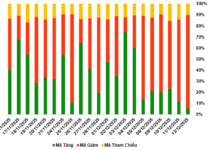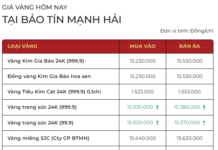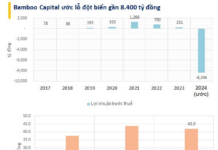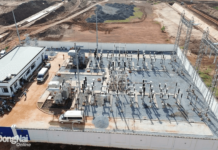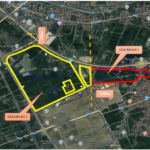The Ba La Bridge, part of the XL-01 package, is a project under the “Enhancing Transport Connectivity in the Central Highlands” initiative, spanning Tay Son District, Binh Dinh Province. This particular section has experienced delays, impacting the timeline for completion. Such delays have directly affected the local residents living on either side of the bridge.
One such resident, Ms. Nguyen Thi Phuong Lan, residing in Ta Giang village, Tay Giang commune, has received over VND 500 million in compensation. She has also partially demolished her house to make way for the construction of the connecting road. According to Ms. Lan, while the contractor has built a retaining wall for the bridge approach, the lack of a proper connecting road has made transportation difficult for the locals:
“All 10 households near the Ba La Bridge have received compensation and dismantled the affected areas of their homes, but the construction is progressing too slowly. I fully support the government’s decision to widen the road, but I request that the contractor expedite the work and provide a proper connecting road for the community, along with a drainage system.”

Ba La Bridge in Tay Giang, Tay Son District, Binh Dinh Province.
The “Enhancing Transport Connectivity in the Central Highlands” project, spanning Tay Son District, Binh Dinh Province, covers a length of 17 kilometers. Thus far, the People’s Committee of Tay Son District has handed over the entire main route and several connecting roads to the investor and construction unit. The district is currently in the process of relocating eight remaining power poles located on the connecting road corridors. The authorities of Tay Son District have noted that while the road construction has caused damage and cracks to the houses and structures of the local residents, the assessment and compensation process for the affected households has been slow.
Presently, out of a total of 1,156 affected households along the route, only 288 have received compensation from the “Enhancing Transport Connectivity in the Central Highlands” project investors. Mr. Nguyen Van Khanh, Vice Chairman of Tay Son District People’s Committee, pointed out that the slow progress of the National Highway 19 expansion project has led to prolonged exposure to dust and air pollution, impacting the daily lives of the locals. Additionally, the lack of drainage systems along the road has further exacerbated the transportation challenges for the community:
“Out of the 1,156 affected households, only 288 have received compensation so far, which has resulted in numerous complaints. With the rainy season approaching, we strongly urge the Project Management Unit 2 of the Ministry of Transport to provide specific instructions to the construction unit, so we can coordinate effectively. Regarding the Ba La Bridge area, while the residents have allowed construction work, the recent rainy season caused water to enter their homes. Therefore, it is imperative for the contractor to closely monitor the situation and address the local issues promptly.”

Delays in constructing the connecting road have caused transportation difficulties.
Representatives from Project Management Unit 2 of the Ministry of Transport stated that over 1,000 households in Tay Son District with cracked houses have been assessed by the insurance company. However, only 288 households have received compensation due to conflicts and disagreements over the assessed compensation amounts. Mr. Le Minh Nam, Deputy Director of Project Management Unit 2, shared that the deadline for the “Enhancing Transport Connectivity in the Central Highlands” project in Tay Son District has been extended to December 31, 2024. He has urged the contractor to complete the remaining items before the rainy season.
Mr. Nam also requested that the Tay Son District authorities promptly resolve the remaining site clearance issues to facilitate the contractor’s completion of the project by October 2024:
“Project Management Unit 2 is also directing the contractor to carpet the C12.5 section from km 50 to km 60 of National Highway 19 to ensure safety and road markings by September 2024. On the An Khe Pass section, we are striving to carpet the C19 section this September. By the end of September, the entire C19 section of the An Khe Pass in Binh Dinh Province will be completed. For the section from km 64+200 to km 64+900, due to the need to lower the foundation and cut the old road, with a maximum depth of 11 meters, this particular section is complex and requires completion of both ends first to ensure uninterrupted traffic flow before constructing the temporary road to avoid rock blasting and mining.”

Multiple upgrade items on National Highway 19, An Khe Pass section, remain unfinished.
In late August 2024, Mr. Le Anh Tuan, Deputy Minister of Transport, held a working session with the People’s Committee of Binh Dinh Province and Project Management Unit 2 to address the obstacles in the transport connectivity project in the Central Highlands region. Mr. Tuan requested that if residents’ houses are affected by the project construction, the investor and contractor must coordinate with the insurance company to compensate the residents. In cases where complaints and lawsuits from households are found to be motivated by personal gain, the matter should be reported to the People’s Committee of Tay Son District and the leaders of the People’s Committee of Binh Dinh Province for appropriate guidance. The Deputy Minister also instructed Project Management Unit 2 and the contractor to focus on completing the National Highway 19 expansion project in Binh Dinh Province on schedule:
“The construction methods should be reviewed, and if there are deviations from the original plan, the insurance coverage from the third party should be increased accordingly. Regarding the six newly affected households who wish to have a connecting road built, procedures must be reviewed and agreed upon between Project Management Unit 2 and Tay Son District. If there are requests or wishes from the people, we should try to fulfill them as best as we can. Out of over 1,000 affected households, only about 200 have received compensation. We need to closely monitor and address the root causes to ensure that even after the road is inaugurated, the compensation for the people will be fully resolved. It is the responsibility of the road construction units to prevent any potential hotspots from occurring.”
The Longest Sea Bridge in Vietnam, Connecting the City Center to the Billion-Dollar Peninsula
The Thi Nai Bridge, spanning the Thi Nai Lagoon in Quy Nhon City, Binh Dinh Province, once boasted the title of Vietnam’s longest bridge for a decade. This impressive structure connects the vibrant city of Quy Nhon to the peninsula of Phuong Mai, a region brimming with untapped economic, social, and tourism potential.
What is the Minimum Lot Size for a Red Book in Binh Dinh Province?
The People’s Committee of Binh Dinh Province has set out regulations regarding minimum land sizes and dimensions for subdivided land plots. These new rules stipulate that residential land plots in urban areas must maintain a minimum area of 40 square meters, with a minimum frontage and depth of 3 meters post-subdivision.
The Great Escape: A Daring Journey on the North-South Highway in Binh Dinh
The North-South Highway Project in Binh Dinh Province spans an impressive 118km. This ambitious undertaking involves navigating through treacherous terrain, including tunneling through mountains and crossing rivers. The construction of this highway is a testament to human ingenuity and perseverance in the face of nature’s challenges. The following images showcase the remarkable progress of this project, offering a glimpse into the sheer scale and complexity of the construction efforts.
Unlocking AI Potential: FPT’s Visionary $4.362 Billion Project for Binh Dinh’s Future
The project is an ambitious initiative with a clear vision to propel Binh Dinh to the forefront of AI innovation in the region. By fostering creativity, investment, and research in AI technology, the project aims to establish Binh Dinh as a hub for artificial intelligence excellence.




